Dispensing Beer with Blended Gases
Mixing carbon dioxide (CO2) and nitrogen (N) gases for dispensing draft beer has become enormously popular at retail outlets such as bars, restaurants, pubs, and large venues. This technique was initially applied for dispensing stout or nitrogenated (nitro) draft beers such as Guinness, Murphy Stout, Boddingtons, and other nitro craft brews. This delivery method requires a CO2 and Nitrogen blend to achieve the correct presentation and flavor in the glass. Blended gas popularity began with dispensing ales and lagers remotely from kegs to the faucets, which requires high system operating pressures.
Today, blended gas technology, such as the Micro Matic MM100, MM200, or MM300 blender series, can supply the appropriate ratios of mixed gas to ales/lagers and nitro beers while protecting the integrity of the product from keg to glass.
The purpose of this document is to describe the features and benefits of dispensing draft beer with a blend of CO2 and nitrogen gases and to present different methods of acquiring a mix of gases and the advantages and disadvantages of each.
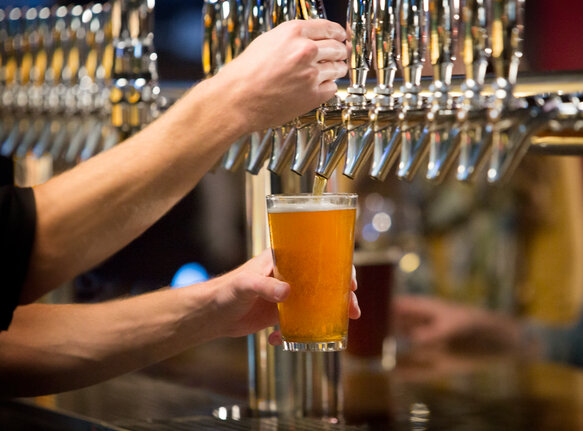
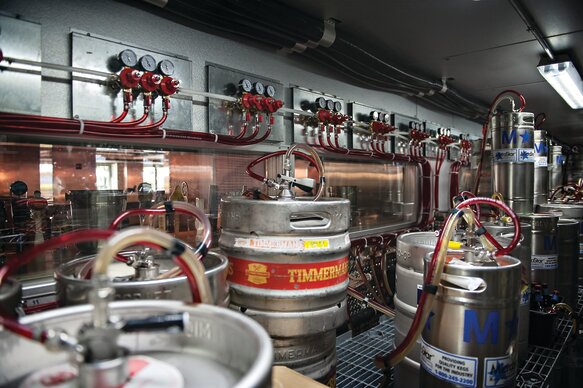
CO2 AND Beer
Carbon Dioxide is natural in the brewing process and is considered an essential ingredient of a brewer's recipe. CO2 has flavor characteristics and must be maintained with the gas pressure source while dispensing or the draft beer will become flat or gassy. Undesirable carbonation results in flavor changes and performance issues including excess foam. This contributes to increased costs per pour and a loss of profit margin for the retail establishment. The key is to apply the correct blended gas ratio to maintain equilibrium in the keg where CO2 in the beer neither leaves nor is imparted into the beer.
CO2 Carbonation and partial pressure
The beer's CO2 content (carbonation) is usually measured in volumes (v/v). Different styles of beer contain different amounts. Beer temperature, pressure applied (pounds square inch gauge – "PSIG") to the keg, and the product's CO2 volume recipe influence the gas blend ratio.
If the CO2 partial pressure in the mix is too low, this allows CO2 to leave the beer and enter the keg's headspace resulting in flat beer. If the CO2 partial pressure is too high in the mix, CO2 is imparted in the top surface layer where the beer and gas headspace meet, saturating this top layer of beer. Once this last quarter of "over-carbonated" beer is eventually at the bottom of the keg, off-taste and performance issues arise. It will be like trying to dispense a beer mousse…all foam.
Nitrogen AND Beer
Nitrogen has the symbol N and is a colorless, odorless, tasteless, and mostly inert gas. It is readily obtainable, constituting 78% of the Earth's atmosphere. Nitrogen is perfect for blending with CO2 and supplying the extra hydraulic push required during dispensing. Limitations do exist while using a blend with nitrogen to pressure the keg. Ideally the pressure is at most 38 PSIG as it then begins to become soluble where nitrogenating of the product starts. Higher nitrogen pressure is the method for infusing or "nitrogenizing" some beers, particularly stouts at the brewery. Making the draft beer smoother with a thicker, tighter-knit head (foam).
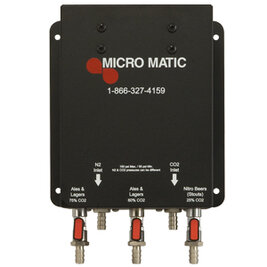
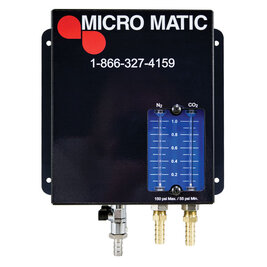
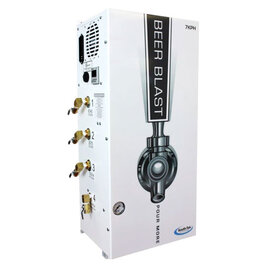
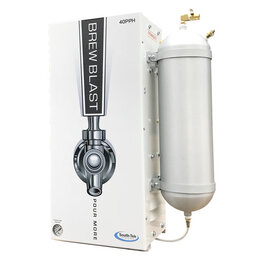
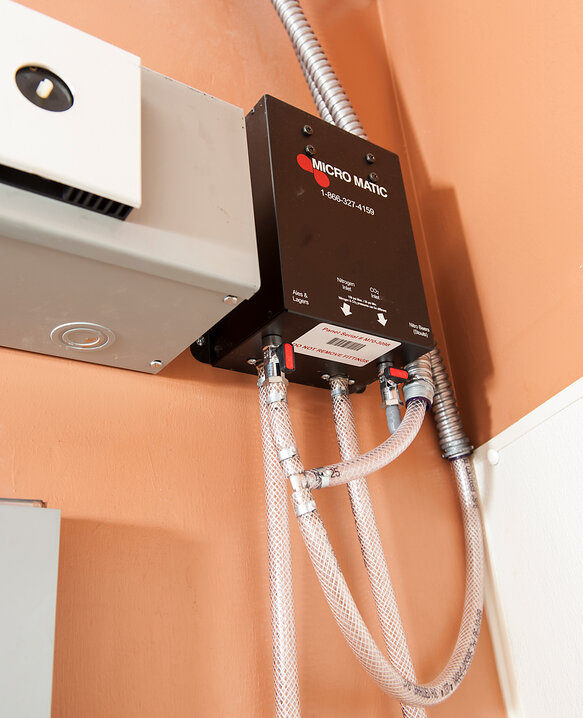
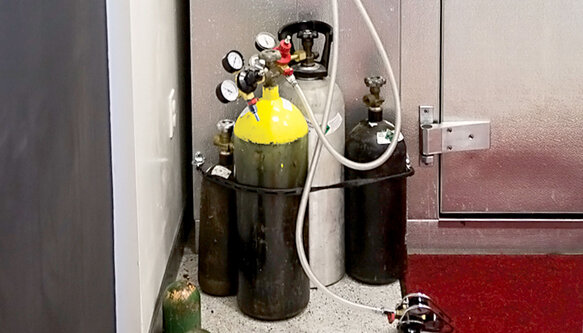

Why Blend Gas?
A nitro stout-style beer typically requires 30+ PSIG to dispense from the keg through the system to stout faucets to acquire the glass's cascading effect and creamy foam head. These beer styles have low CO2 (v/v) content and require a lower CO2 ratio in a blend (often 25%) at 30 PSIG to keg. The remaining high nitrogen ratio in the mix provides extra push through the faucet ensuring a quality presentation and a great-tasting beer.
Ales & lagers have more than twice the CO2 volumes than nitrogenated stout-style beers. They are not nitrogenated but their natural carbonation must be protected while dispensing. Many direct draw dispense systems, such as kegerators, use 100% CO2 at a low 12-15 PSIG to the keg to accomplish this.
These lower pressures are often inadequate which creates performance issues when the system design requires dispensing through long distances to the faucet. The higher pressure of a blended gas is then necessary. CO2 in the blend takes care of the ale/lager's higher carbonation partial pressure. The lower inert nitrogen in the ratio is only used as additional propelling pressure to overcome any challenges due to system length. Unlike nitro beers, more CO2 and less nitrogen in the mix are needed to maintain the beer's flavor, quality, and performance during dispensing. Higher applied blended gas pressures benefit systems over 15 feet long and those with chronic temperature fluctuations.
Gas Blend Ratio
The gas blend ratio is based on the product's CO2 volumes, the temperature of the beer, and the required applied pressure to the keg.
CO2 volumes for stout beers such as a Guinness range from 1.2 volumes to craft stouts with up to 1.7 volumes. Ales and lagers can range from 2.2 up to 2.8 volumes, and in some craft beers and Hefeweizens, the carbonation may exceed 3 volumes.
The ideal liquid temperature is 38° F. A survey of American consumers finds this to be a very desirable temperature for consumption, and the CO2 in the beer is very stable.
The "PSIG" at the keg using mixed gas normally range from 20 to 25 PSIG for ales and lagers and up to 30-40 PSIG for stouts. To acquire equilibrium with stouts, a 25% CO2/75% nitrogen mix is ideal, and for ales and lagers, a 60% CO2/40% N ratio is required. Domestic lagers from large American Brewers will require up to a 75% CO2/25% N ratio.
Sources of Blend Gas
Pre-mixed gas from cylinders and on-site blending are the two sources of blended gas for dispensing draft beer. Mixed gas in a gas cylinder is usually 25% CO2 and 75% N available through local gas suppliers. It is commonly called "beer gas" or "Guinness gas."
The pre-mixed 25% CO2/75% N gas ratio is appropriate for nitro stout beers. However, when applied to ales and lagers, the beer will go flat because the partial pressure of CO2 from the blend needs to be higher. Gas suppliers have difficulties raising the ratio of CO2 in the cylinder as it eventually liquefies under high pressure. Costs are high, blend accuracy can be unreliable, and a cylinder's overall volume of gas can only dispense a few kegs.
Unfortunately, pre-mixed gas blends have been improperly applied to ales and lagers. This is a costly mistake as these beer styles will become flat due to the low ratio of CO2 in the blend directly impacting the resale of a profitable product at retail while also driving customers elsewhere to enjoy properly carbonated draft beer. Micro Matic on-site blenders are the preferred source for blended gas as they can provide correct ratios for all beer styles.
Micro Matic gas blenders offer on-site blending of a source of either bulk or cylinder CO2 and nitrogen from a cylinder or Micro Matic's Beer Blast nitrogen generator. The blender technology provides a very accurate (+/- 2%) blend gas mix ratio of the supplied gases. An auto shut-down feature exists if one of the gas supplies depletes protecting coupled keg inventory from any carbonation changes. They are both easy to install and tamper-proof. Multiple preset blenders are ready to ship and are available with single, dual, or triple gas blends. Blender's investment has a quick payoff as gas costs are minimal, and revenue increases where resale is encouraged.
The MM100 offers a single blend of 70% CO2/30% N for ales and lagers. The MM200 delivers 70% CO2/30% N for ales and lagers and 25% CO2/75% N for nitro stout (nitrogenated) beers. A 60%/40% CO2 ratio is available with single and dual blenders (MM10060-40 & MM200 60-40). These blender models are available with in-line leak detectors where the part reference ends with "LD."
The MM300 features a triple blend option with preset blends of 25% CO2/75% N for nitro stout beers – 60% CO2/40% N for lower carbonated ales and lagers – and 75% CO2/25% N for domestic lagers and other highly carbonated beer styles. Custom gas blenders are available for those applications requiring precise blended gas ratios. Micro Matic's Beer Blast nitrogen generator is available with an onboard dual blender.
Brewers Association and Blended Gas
The Brewer's Association Draught Beer Quality Manual is a comprehensive draught beer reference. Their technical committee included extensive information about beer carbonation, blended gas, gas laws, and partial pressures.
Presenting a Great Tasting Beer
Today, Micro Matic's dispensing technology allows all beer styles to be dispensed successfully, keeping costs low while driving additional sales. Gas blenders, revolutionary barrier tubing, 304-grade stainless contact, efficient glycol chillers, innovative installation techniques and effective tubing/glassware cleaners all work together to create a properly functioning system.
Invest in a Micro Matic-designed dispensing system, including a gas blender, to complete the perfect final draught system. The return on system cost is quick and consumers will return repeatedly.
Raise a Glass to Draft Beer Sales!
For over 60 years, Micro Matic has been recognized as one of the world’s leading suppliers of draft beer equipment. Specializing in keg-to-glass technology, we offer a total solution for meeting your draft beer equipment needs. Our dedication to customer service is supported by four regional sales and distribution centers, the Micro Matic Dispense Institute for training and education, and a Certified Installer Network for draft beer installations. Want to speak with a “perfect pour” expert? Contact Micro Matic today.